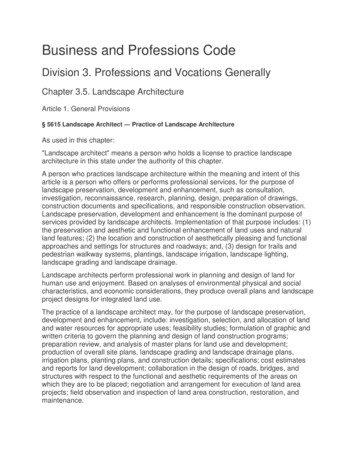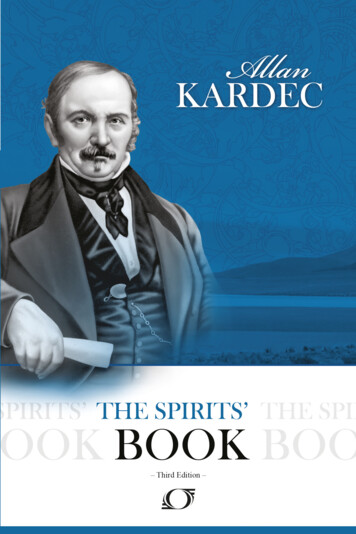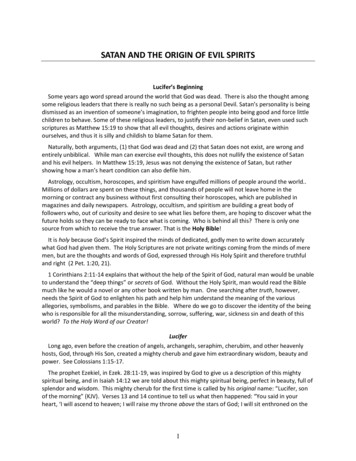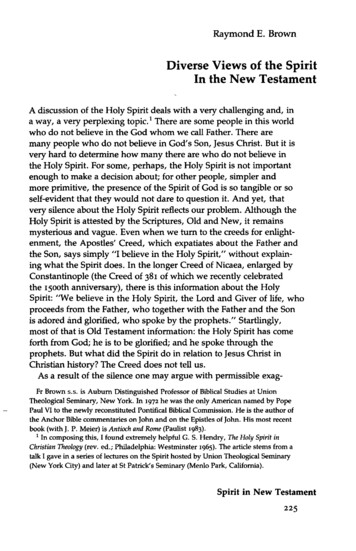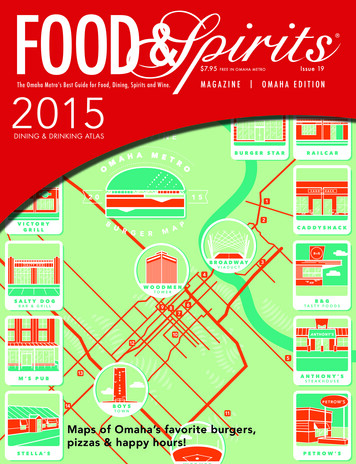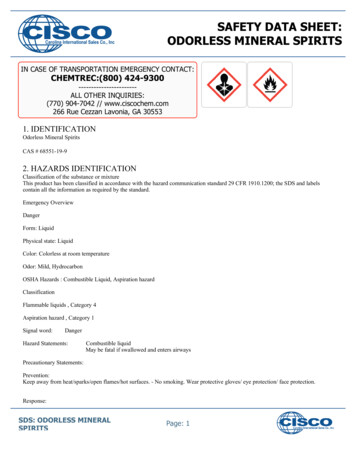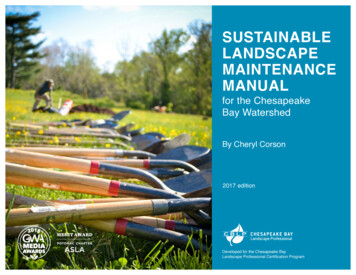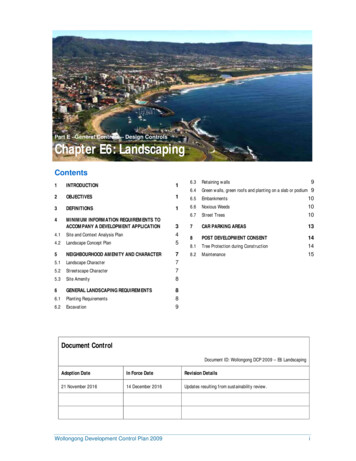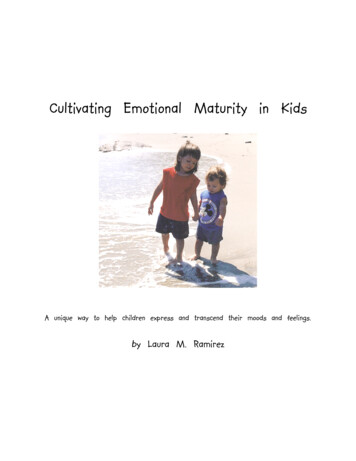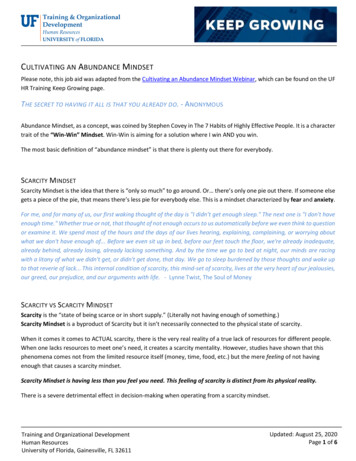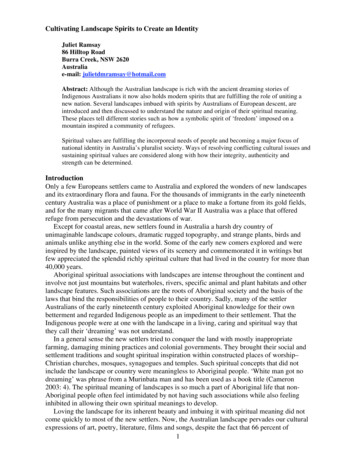
Transcription
Cultivating Landscape Spirits to Create an IdentityJuliet Ramsay86 Hilltop RoadBurra Creek, NSW 2620Australiae-mail: julietdmramsay@hotmail.comAbstract: Although the Australian landscape is rich with the ancient dreaming stories ofIndigenous Australians it now also holds modern spirits that are fulfilling the role of uniting anew nation. Several landscapes imbued with spirits by Australians of European descent, areintroduced and then discussed to understand the nature and origin of their spiritual meaning.These places tell different stories such as how a symbolic spirit of ‘freedom’ imposed on amountain inspired a community of refugees.Spiritual values are fulfilling the incorporeal needs of people and becoming a major focus ofnational identity in Australia’s pluralist society. Ways of resolving conflicting cultural issues andsustaining spiritual values are considered along with how their integrity, authenticity andstrength can be determined.IntroductionOnly a few Europeans settlers came to Australia and explored the wonders of new landscapesand its extraordinary flora and fauna. For the thousands of immigrants in the early nineteenthcentury Australia was a place of punishment or a place to make a fortune from its gold fields,and for the many migrants that came after World War II Australia was a place that offeredrefuge from persecution and the devastations of war.Except for coastal areas, new settlers found in Australia a harsh dry country ofunimaginable landscape colours, dramatic rugged topography, and strange plants, birds andanimals unlike anything else in the world. Some of the early new comers explored and wereinspired by the landscape, painted views of its scenery and commemorated it in writings butfew appreciated the splendid richly spiritual culture that had lived in the country for more than40,000 years.Aboriginal spiritual associations with landscapes are intense throughout the continent andinvolve not just mountains but waterholes, rivers, specific animal and plant habitats and otherlandscape features. Such associations are the roots of Aboriginal society and the basis of thelaws that bind the responsibilities of people to their country. Sadly, many of the settlerAustralians of the early nineteenth century exploited Aboriginal knowledge for their ownbetterment and regarded Indigenous people as an impediment to their settlement. That theIndigenous people were at one with the landscape in a living, caring and spiritual way thatthey call their ‘dreaming’ was not understand.In a general sense the new settlers tried to conquer the land with mostly inappropriatefarming, damaging mining practices and colonial governments. They brought their social andsettlement traditions and sought spiritual inspiration within constructed places of worship–Christian churches, mosques, synagogues and temples. Such spiritual concepts that did notinclude the landscape or country were meaningless to Aboriginal people. ‘White man got nodreaming’ was phrase from a Murinbata man and has been used as a book title (Cameron2003: 4). The spiritual meaning of landscapes is so much a part of Aboriginal life that nonAboriginal people often feel intimidated by not having such associations while also feelinginhibited in allowing their own spiritual meanings to develop.Loving the landscape for its inherent beauty and imbuing it with spiritual meaning did notcome quickly to most of the new settlers. Now, the Australian landscape pervades our culturalexpressions of art, poetry, literature, films and songs, despite the fact that 66 percent of1
Australians live in the capital cities. As coastal cities swell and rural towns disappear, the loveof Australian landscapes is not diminishing. Many city dwellers hold strong personalattachments to landscapes such as beaches or bushlands where their best holidays took place.Unlike the histories of Europe, Asia and even North America that have been shaped bytraumatic wars and natural disasters, Australia has had few such experiences. We do not havelandscapes ringing with the spirits of countless dead, although we do have places of conflictthat were deeply tragic to those involved.This paper is not about places that provide a personal ‘sense of place’, nor those places thatprovide nostalgia for the past. It is about landscape places that have acquired a spiritual valuerecognised well beyond their locale. The comparatively short history of the settler Australiansallows us to analyse a few fledgling landscape spirits, and consider how the ‘spiritual loci’ oflandscape places is established and woven into the incorporeal needs of the cosmopolitanAustralian nation, contemporary heritage, and for better or worse, the tourism economy.Several examples of landscapes with well-known intangible associations are presented anddiscussed and although different in their origins, the examples convey a set of milestones inthe narrative of the evolving national character.Port ArthurCommencing 1832 as a small forestry camp, Port Arthur became one of the largest Imperialconvict institutions in Australia. The Port Arthur landscape is a paradox. It is immenselypicturesque, located beside a small bay that is approached through capes with huge cliffs thatare pounded by rough seas. The landscape amphitheatre of Port Arthur by contrast, is tranquilfacing a small central island and backed by forested hills. For convicts, however, theexperience of Port Arthur was traumatic – being forced to leave the land of their birth andtheir families to endure confinement and punishment in a strange country on the other side ofthe world. Port Arthur was known as a place of misery and also, but unjustifiably, as the mostinfamous convict prison in Australia. Its relic features are sufficiently substantial to convey thescale of the place and nature of the prison, particularly the separate prison and solitary cellswhere prisoners were punished by solitary confinement, while the centrally located churchsymbolises the role of the church as a goal for reform. Near the main bay is the Point Puerboys prison where boys as young as seven were imprisoned (AHDB 2005).Australia’s convict past, epitomised by Port Arthur has been considered by many as a blighton the collective character of modern confident Australians. Coming to terms with the ghostsof the convict days was being achieved when in 1996 a gunman chose Port Arthur to make hismark. The gunman took the lives of 32 people and wounded 19 others. A memorial to thatevent is now another poignant feature of the place. Despite its landscape beauty, Port Arthur isan intensely evocative place where visitors cannot help but be moved by a spiritual aura ofmelancholia and tragedy that personifies a foundation stone of Australia’s national identity.Kelly CountryMany convicts that were sent to Australia were from Ireland. Some were political prisonersand some were forced into theft by poverty and an oppressive government. The family of theformer Irish convict Red Kelly (who served a term at Port Arthur and was later imprisoned inVictoria) lived in North East Victoria maintaining a modest rural lifestyle on a small selectiontaken up by Kelly’s wife in 1867 close to the rugged foothills of the Australian Alps. TheKellys were a large family with 12 children and their father Red Kelly, died when his son Nedwas 12 years old. They were poor Irish Catholics – a class of people specifically excludedfrom holding public office or government positions until after 1900. The Irish had, not withoutreason, a dislike of the British authority.2
Ned, while a youth rescued a boy from drowning and was awarded for his bravery but laterran foul of the law and with his small gang of fellow outlaws, including his brother Dan –hidout in the bush (Jerilderie Historical Society, 2000). Kelly passionately hated the police whovictimised his family and in an incident in 1873, he killed three policemen but believed he wasjustified. In 1879, in the town of Jerilderie, he produced an anguished fifty-six page letter anddemanded that the letter be published, a demand that was not fulfilled in his lifetime. In theletter he decried the treatment of his family and himself by the Victorian police whom hedescribed rather unflatteringly.‘I have been wronged and my mother and four or five men lagged innocent and is mybrothers and sisters and my mother not to be pitied also who has no alternative only toput up with the brutal and cowardly conduct of a parcel of big ugly fat-necked wombatheaded big bellied magpie legged narrow hipped splaw-footed sons of Irish Bailiffs orenglish landlords which is better known as Officers of Justice or Victorian Police (Kelly1879, 43)Kelly and his gang had many sympathisers in the region during their time of activebushranging (living as a bandit) and a network of friends provided the gang with food. Tosome he was regarded as a ‘Robyn Hood’ and his Jerilderie letter noted his desire to supportwidows and orphans. His final dramatic stand was in 1880 at the town of Glenrowan wheremembers of his gang were killed while Ned was wounded and captured wearing homemadeiron armour. Five months later he was hung in Melbourne.The legend of Ned Kelly now flourishes in the region with Glenrowan at the epicentre.Throughout the landscape are features such as his lookout site, the Beechworth Prison wherehe and family members were imprisoned, hut ruins and tracks that form the tangible evidenceof the legend. Bolstering the legend are films, with Ned being played by stars such as MikeJagger and more recently by Heath Ledger. There are numerous paintings including a series ofNed Kelly in his armour by Sidney Nolan and numerous books such as the True History of theKelly Gang by Peter Carey all of which capture the heroics and the pathos of this unhappy life.In 2000, Ned Kelly in armour was featured as an Australian icon at the Olympic Games. Thespirit of the Kelly Country is the legend of the escapades of the defiant Ned Kelly.The Dig TreeBy the mid-nineteenth century, new settlers wanted to establish pastoral properties in theinland areas, and in 1860, encouraged by a large crowd of well-wishers, an explorationexpedition led by Robert O’Hara Burke left Melbourne to cross Australia to the Gulf ofCarpentaria with the objective of gathering information about grazing lands and otherresources in unclaimed territory. The expedition party was large, with 18 people, 25 camels,22 horses, some wagons, two years supply of food, as well as 80 pairs of shoes, beds, hats andbuckets, and some firewood.The expedition made a depot camp on the banks of Coopers Creek at Bulloo Bulloowaterhole in the area of land now the northwest corner of New South Wales. Burke, and threeothers Wills, Gray and King, set off leaving William Brahe and his party at the waterhole withinstructions to wait three months. The depot party actually waited at Coopers Creek for overfour months but before leaving Brahe buried some provisions in case the Burke party didreturn and carved a message on a tree to mark the spot ‘Dig 3 ft NW’. Although Burkes partyreached the Gulf their expedition was a disaster. They underestimated the harsh conditions ofthe country and their food requirements and Gray fell ill and died. Burke, Wills and Kingfinally arrived back at the depot on the evening of 21 April 1861 exhausted with only twosurviving camels and almost no food to discover that Brahe had departed that same day.The three men left the site following the creek and eventually Burke and Wills perished(AHDB 1983).3
The Dig Tree landscape is the waterhole and its landscape setting. The Dig Tree is a matureCoolabah (Eucalyptus microtheca) believed to be around 200 years old. Nearby is a later treecarving of Burke by John Dick in 1898, called the Face Tree, while a few kilometres away arethe graves and memorials where Burke and Wills died. While other explorations with fewermen and provisions successfully crossed the continent without any loss of life, it is this storyof misadventure and the tragic spirits of the Dig Tree landscape that are best remembered inpopular histories.Barcaldine Shearer’s Strike CampSome thirty years after the Dig Tree episode, when pastoralists properties were wellestablished in the outback, shearers lived and worked in appalling conditions. Although theytried to negotiate standard reasonable conditions through their union, the pastoralists drew uptheir own agreement employing whom they liked. As a result a thousand shearers rallied inJanuary in 1891 and set up a strike camp near the town of Barcaldine in southwestQueensland. The strike was eventually broken by police and military troopers in May of 1891and the six strike leaders arrested and charged with sedition and conspiracy. However, theshearers’ resistance was a watershed in Australian political history that transformed theloosely knit workers into a political force, instigated the election of the first Labourrepresentative to a parliament and the beginning of workers in politics. Barcaldine is regardedas the birth place of the Australian Labour Party (Egloff, O’Sullivan and Ramsay 1991).The strike camp site was a travelling stock reserve and although intermittently used for thatpurpose it remains today virtually unaltered since the event. It is in the western extent of the’Brigalow’ belt landscape – flat with hardy shrubs and grasses and occasional trees such asGidyee (Acacia cambangi) and Eucalypts in the creek courses.The shearers’ strike of 1891 is portrayed in a picture painted at the campsite. A few featuresfrom the event remain such as the blazed tree that carried the shearers’ motto –‘United WeStand Divided We Fall A.L.F. The Strike Camp 1891’ and numerous artefacts from the strikewere located by archaeologists in 1990. The poem by Henry Lawson 'Freedom on theWallaby' conveys the rallying emotion at the start of the strike.So we must fly a rebel flag,As others did before us,And we must sing a rebel songAnd join in rebel chorus.We'll make the tyrants feel the stingO' those that they would throttle;They needn't say the fault is oursIf blood should stain the wattle! (Lawson 1891)However, the poem 'On the Wallaby' written by Lawson soon after the strike was broken,excludes the word ‘Freedom’ in the title and captures the broken spirits of the workers whenthey were forced the abandon the strike (Egloff, O’Sullivan and Ramsay 1991): When my tent is all torn and my blankets are damp,And the rising flood waters flow fast by the camp,When the cold water rises in jets from the floor,I lie in my bunk and I list to the roar,And I think how to-morrow my footsteps will lagWhen I tramp ’neath the weight of a rain-sodden swag.4
The strike and others like it established the profile of the hard working ‘battler’ embellishedby the bush ballads of the era and today the spirits of the campsite must rejoice when theresults of their efforts, the Australian Labour Party is in government Federally and in everyAustralian State.The High Country and the Man from Snowy RiverA few years after the Strike Camp event another Australian legend was born in a landscapevery different to that of the flat Brigalow belt. It arose in the landscape of Australia’s highestmountains proudly called the Australian Alps or more colloquially the ‘high country’ where aparticular set myths and traditions of Australian identity were born. The high country of theSnowy Mountains is the locale of Australia's most famous man of the mountains – 'The Manfrom Snowy River', a mythical man that appeared in a poem published in 1895. It is the storyof a valuable racehorse, which escaped into the rugged mountain country and joined a mob of‘wild bush horses’. Although the best riders in the region gathered to chase the wild horsesand capture the valuable racehorse, the country was too difficult for all of them - except forone person, the Man from Snowy River riding his ‘small and weedy horse’.As heroes go he is admirable, small, tough, modest and with great horsemanship skills. Heand his horse (part Timor pony) symbolise courage and endurance. The landscape they arepart of is wild and powerful and the imagery in the poem is rich with action.But the man from Snowy River let the pony have his headAnd he swung his stockwhip round and gave a cheerAnd he raced him down the mountain like a torrent down its bed,While the others stood and watched in very fear (Patterson1895).The mythical man was adopted by the mountain stockman who practiced high countrygrazing for 150 years. The Man from Snowy River, decked out in a ‘Driazabone’ coat(whether he wore one or not) and riding his horse is the iconic symbol of that life style. Someclaim the man was Jack Riley from Corryong, but the ‘man’ was essentially the creation of apoet Andrew Barton (Banjo) Paterson, a Sydney lawyer who produced numerous rollickingballads of a highly romanticized rural life that he marginally experienced. A popular paper, theBulletin, published his poems and The Man from Snowy River inspired the nation.The poem has given rise to two films, The Man from Snowy River and Return to SnowyRiver, as well as a TV series. The Man did not die like his creator and a web site will tell youthat every year ‘the Man from Snowy River Festival is held in April at the town of Corryongto celebrate the heritage of the high country with Riley's Ride, bush poetry, a parade, a wineand food festival and much more’.Other than the National Park Service which has been trying to expunge wild horses, grazingcattle and horse riders from the alps, most people love this mythical character the spirit of themountains and the Snowy River and the last lines of the poem couldn’t be more true‘the Man from Snowy River is a household word today‘and the stockmen (now the nation) tell the story of his ride’The man and his horse, the spirit of freedom and heroism live on, they opened the AustralianOlympic Games and you can find them featured on the Australian 10 note.Mount KosciuskoThere is another spirit being nurtured in the high country. It is the spirit of Kosciuszko. MountKosciuszko is Australia’s highest mountain, named by the Polish explorer Count Paul deStrzelecki after the Polish freedom fighter General Tadeusz Kosciuszko who believed inequality and lobbied for human rights and liberation of slaves. When Strzelecki viewed thehighest point in Australia it reminded him of the famous hill monument built by Poles in5
Krakow and he wrote ‘amongst a free people who appreciate freedom and its votaries, I couldnot refrain from giving it the name of Mount Koscisuzko’ (Andrews, 1991).Unlike Strezelecki, 60,000 Polish people came to Australia to seek political refuge during1947-53, migrating from war torn Europe and the Nazi Holocaust (Polish Historical Society2008). In 1988 the Polish Republic donated a statue of Strezlecki to Australia that is located inthe mountain town of Jindabyne. In recent years, the Polish community and Puls Polonii haveorganised an annual festival in the mountain towns and in 2007 it featured a pilgrimage to thesummit of Mt Kosciuszko to appreciate the spirit of Kosciuszko, the man and the mountainwith songs, music and dancing, and a Catholic Mass by Polish Jezuit priests.Mount Kosciuszko, as the summit of Australia is at 2228 m and about a 10 km round tripwalk from the nearest carpark. Over 100,000 people do the summit walk each year. The name,Kosciusko, has been extended to the surrounding national park but is mostly not pronouncedsoftly as in Polish. Pronounced the Australian way it springs off the tongue and many give itthe affectionate abbreviation of ‘Kosci’. Mt Kosciuszko is familiar to all Australians andalthough not all know who gave it that name or why, thanks to the Polish community, thespiritual association of freedom and democracy grows stronger each year.Hanging RockIn central Victoria is a small rocky hill known as Hanging Rock. Geologically the hill is avolcanic plug (mamelon) and a landmark feature arising from the surrounding countryside in aseries of vertical pinnacles. Hanging Rock has been a Crown Reserve since 1884 and arecreational feature since the 1860s (AHDB 1991). It also has an associational history with thebushranger Dan (mad dog) Morgan who used the place as a lookout.Hanging Rock is imbued with a mystery and one website states that it is famous because itis where five school girls went missing during an excursion in the early twentieth century andwere never found (Fiona and Ashley 2008) but the website fails to note, probablypurposefully, that the story is a work of fiction by the writer, Joan Lindsay, published in 1967.The story became more widely known when it became a feature film in 1975, directed byPeter Weir. The evocative film utilised the unusual rock formations with their narrowpassageways along with eerie exaggerated insect sounds to add tension to the sense ofmystery. And so a small segment of landscape has been imprinted with a myth and althoughbarely 50 years old, the story has metamorphosed the place into a landscape of mystery withthe lingering fictional spirits of the missing schoolgirls.The Franklin and Gordon RiversOther landscapes in Australia have initiated hard struggles to become protected landscapes.Today in Tasmania one can visit the Franklin Gordon Wild Rivers National Park, a landscapeof powerful wild river beauty. Although most national parks have developed from communitycampaigns to save landscapes of beauty or scientific importance, in this case the campaignwas a particularly hard battle that divided Tasmanian communities. The Tasmanian StateGovernment in 1982, decided to build a dam near the junction of the Gordon and FranklinRivers in Tasmania's southwest. Many Tasmanians were in favour of the dam believing that itwould generate much-needed jobs while others wanted to protect the landscape. A huge mediacampaign incited protests around the nation, blockades on the river by a fleet of rubberduckies, and appeals by eminent scientists defended the protection of the river. A focus of thecampaign was an evocative landscape image, ‘Rock Island Bend’ by the landscapephotographer, Peter Dombrovskis.On the 1 July 1983, the High Court of Australia overturned the Tasmanian government’sdecision using federal powers to protect world heritage. The case was a landmark inAustralia’s environmental and constitutional history that confirmed the federal government’s6
power to intervene and protect sites of world heritage value. It led to the protection of theFranklin River and to the formation of the Australian Greens Party. The campaign thatinvolved valiant efforts of many protestors has imprinted the landscape with a lingering spiritand inspired other campaigns to save special forests such as Terrania Creek, the Daintree andthe Lemonthyne.Gulaga – Birthing Woman- Mother MountainDuring the last 40 years the Aboriginal associations with landscapes have become moreknown to other Australians through the popularity of Aboriginal art, books, stories anddancing. As previously noted the Aboriginal bond with the landscape is an indivisible link ofspiritual importance, stories, art and ‘caring for country’. There are also countless places ofnewer spirits significant to contemporary Aboriginal people, some of which are sites ofmassacres such as the Myall Creek Massacre landscape, places of dispossession and places ofasserting independence and traditional rights such as the Wave Hill Walk Off Route (AHDB2008, 2007). There are also places where the dreamtime spirits are so strong that they appearto also embrace the non-Aboriginal people. One such place is Gulaga originally named MountDromedary by Captain Cook because of its double humped form.Gulaga, a mountain clad in temperate forest, is a dominant landmark feature of the southcoast of New South Wales. As told by one of the elders; ‘it is sacred to the Yuin nation andhas a dreamtime story that brings people back to where their spirits can rest in their own land.To the Yuin nation she has always been the mother mountain, a place of great power, forwomen especially, but also to men. Gulaga is regarded as a place for teaching, creating, curingand protecting (AHDB).Another story is that Gulaga had two sons Barranguba and Nadjanuga. Barranguba ranaway to the sea and is now an island. Nadjanuga stayed near his mother Gulaga as a smallrocky hill. The story parallels the geological history – 95 million years ago Gulaga was avolcano and Nadjanuga and Barranguba were two subsidiary volcanoes while the guardians ofGulaga, are the dominant extrusions of large tors of monzonite rock. There is also an apron ofvolcanic soil flowing from the Gulaga to the sea that was cleared of its forest by settlers whoexploited the highly fertile soil to sustain a dairy industry, two cheese factories and theirassociated workers’ towns of Central Tilba and Tilba Tilba nestled in the Gulaga foothills(Peter Freeman et al 1992). Although only the Yuin know the details of the sacred places,Gulaga is an omnipresence spirit that dominates the dreamtime story, the scientific story andthe settler story as well as appearing in the literature of the region such as the award winningtrilogy Just Relations by Rodney Hall (1982) and poems such as the following by a localresident.We see her now head thrown back,Knees drawn up,Gently curving breasts and belly against the skySometimes winter covers her with a possum cloak – a mist. (Amy Abbott 1989)DiscussionThe examples of landscapes with spirits have been selected to convey the acquisition of anational identity through imprinting spirits and iconisation of landscapes. The spirits of PortArthur epitomise the melancholia of those forcibly brought to the country while the spirit ofNed Kelly in the Kelly Country, portrays how a first generation individual defied spurious lawofficials to defend his family. The spirits of the Dig Tree landscape are evidence of how thedreams of the new nation were pinned to the Burke expedition only to be devastated by itsdisastrous demise. Coming near the end of the nineteenth century, the spirits of the BarcaldineShearers’ Strike, remind of how some people endured difficulties and punishment in seeking7
for improved social conditions for the working class. A little later, around the time when thecolonial governments were forging national unity through Federation, the poet, BanjoPatterson gave birth to the Man from Snowy River. At the turn of the century this spirit wasone the newly formed Australian nation needed – the quiet, modest, skilful, courageous personand his horse, who ‘conquered’ one of the roughest landscapes in the country. The less wellknown but equally fictitious mystery of Hanging Rock denotes how we desire to imprintspirits onto the landscape. In the twentieth century there is the emerging uplifting spirit ofKosciuszko, to remind us of the best of human values while the spirits of the Franklin Riverand various forest landscape battle-grounds epitomise the nation’s recognition of Australia’slandscape beauty and our passionate efforts to safeguard it.From the examples provided it is plain that spiritual loci is definitely strengthened byartistic and literary works of any degree of sophistication. A ballad or a folk song is just assuccessful in fortifying spiritual loci as a classical masterpiece.Although the spirits discussed are popular nationally and the landscapes they inhabit areanchored in heritage lists, the spiritual value is still immature. Can modern Australians acceptthe concept of spiritual places? Haydn Washington in his work A Sense of Wonder (2002)quotes the philosopher John Passmore who said that sacred landscapes were ‘mysticalrubbish’. In arguing against Passmore’s harsh words and devotion to rational thought,Washington quotes Einstein who noted ‘the most beautiful thing we can experience is themysterious –It is the source of all art and science’ (Washington 2002, 81). Australians travellong distances to contemplate, enjoy and be emotionally affected by the wonders andmeanings of the Australian landscapes but because of prevailing western rational philosophyfew will admit to the concept of embracing the spirits of the place.Many other nations recognise spiritual landscape value. A discussion by Olwen Beazley onsacred mountains in 2003 analysed a selection of World Heritage listed mountains thatincluded the Chinese World Heritage sacred Mt Lushan and Mt Emei that have spiritualimportance while Mt Tai and Mt Wuyi are associated with the birth of philosophical andreligious doctrines that shaped their nation. Mt Althos (Greece) and Mt. Althos (Egypt) alsohave strong spiritual association (Beazely 2003, 5). There are numerous spiritual landscapesthroughout the world such as the megaligth landscapes of Europe, the British Isles, Asia andalso the Pacific that are strongly associated with myths, legends or ancient religions.It is encouraging to note how many if not most ancient cultures accept and revere spirituallandscapes. It is also interesting to contemplate on the origins of their spiritual meanings andjust how long did it take from the earliest germination of spiritual meaning to full-blownsacred landscape status. For some of the fledgling ‘white man’ spirit places described in thispaper it may be hundreds of years before there is a full flowering of their spiritual influence.ManagementLandscapes such as the ones described are associational cultural landscapes that illustrate theinteraction of humans and nature. The identification of heritage involves considering theauthenticity and integrity. For associational cultural landscapes, establishing the values relieson gathering as much evidence of intangible association from as many sources as possiblesuch as art, literature, experts, community, tourism advertising and now web sites to establishboth the quantity and quality of the association. The quantity confirms that the value existsbroadly and has meaning for m
Spiritual values are fulfilling the incorporeal needs of people and becoming a major focus of national identity in Australia's pluralist society. Ways of resolving conflicting cultural issues and sustaining spiritual values are considered along with how their integrity, authenticity and strength can be determined. Introduction
